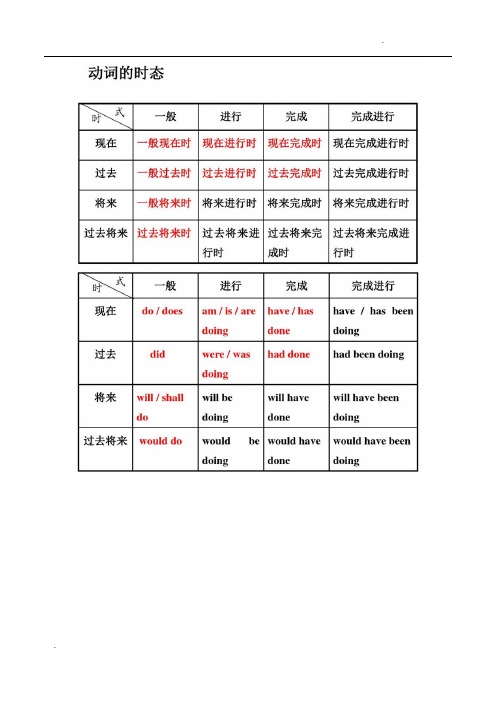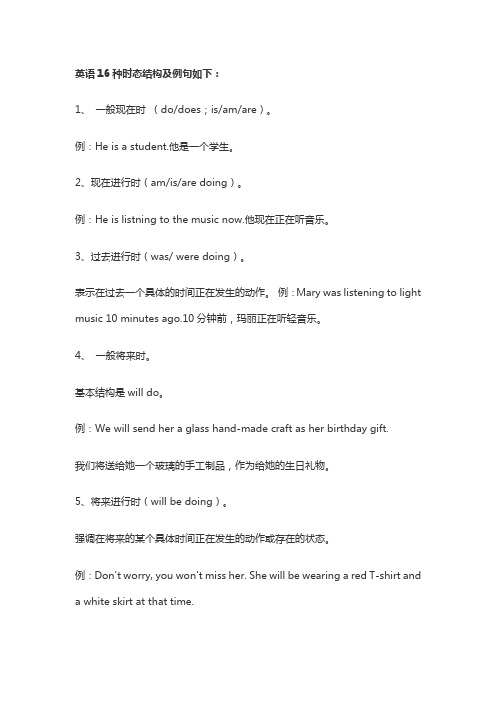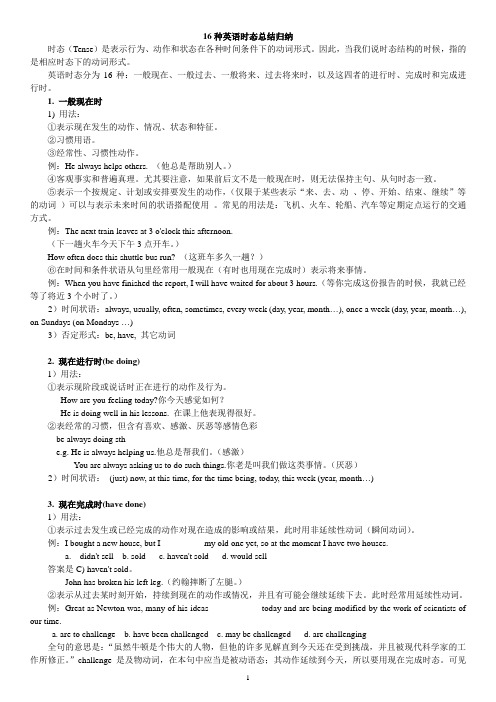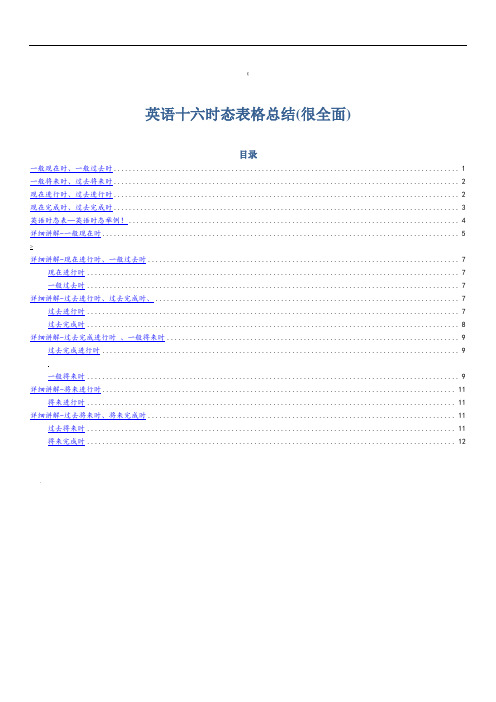英语中的16种时态(全)
英语中的16种时态

英语中的16种时态英语时态分为16种,下面就为大家一一列举:1、一般现在时态:表示现在的状态,或者经常反复发生的动作或习惯。
例如:I am a student.我是一名学生。
2、现在进行时态:表示正在进行的动作或存在的状态。
例如:He is studying.他在学习。
3、现在完成时态:表示过去发生的动作对现在造成的影响或结果。
例如:I have finished my homework.我已经完成了我的作业。
4、现在完成进行时态:表示从过去开始一直持续到现在的动作或状态。
例如:We have been waiting for you for hours.我们已经等了你几个小时了。
5、过去一般时态:表示过去某个时间点的状态或动作。
例如:He wasa teacher.他是一名老师。
6、过去进行时态:表示过去某个时间点正在进行的动作或存在的状态。
例如:They were playing football at that time.他们在那个时候正在踢足球。
7、过去完成时态:表示过去的过去,即过去某一时间之前发生的动作或状态。
例如:They had finished their work before we arrived.在我们到达之前,他们已经完成了他们的工作。
8、过去完成进行时态:表示过去某一时间之前一直在进行的动作或状态。
例如:We had been waiting for the bus for hours before it finally arrived.在公共汽车最终到达之前,我们已经等了好几个小时。
9、将来一般时态:表示将来某个时间点的状态或动作。
例如:She will be a doctor.她将成为一名医生。
10、将来进行时态:表示将来某个时间点正在进行的动作或存在的状态。
例如:We will be studying in the library tomorrow afternoon.我们明天下午将在图书馆学习。
英语16种时态超经典整理

英语的16种时态1.一般现在时the present tense2.一般过去时the past tense3.一般将来时the future tense4.一般过去将来时the past future tense5.现在进行时the present continuous tense6.过去进行时the past Continuous Tense7.将来进行时the future continuous tense8.过去将来进行时the past future continuous tense9.现在完成时the Present Perfect Tense10.过去完成时the Past Perfect Tense11.将来完成时the future perfect tense12.过去将来完成时the past future perfect tense13.现在完成进行时the present perfect continuous tense14.过去完成进行时the past perfect continuous tense15.将来完成进行时the future perfect continuous tense16.过去将来完成进行时the past future perfect continuous tense1、一般现在时(1)一般现在时表示没有时限的持久存在的动作或状态或现阶段反复发生的动作或状态,常和副词usually,often,always sometimes,regularly,near,occasionally,every year, every week 等连用。
例如:1)The moon moves round the earth..2)Mr. Smith travels to work by bus every day.(2)在由after,until,before,once,when,even if,in case,as long as,as soon as,the moment 以及if,unless 等引导的时间状语从句或条件状语从句中,通常用一般现在时代替将来时。
16种时态例句

英语16种时态结构及例句如下:1、一般现在时(do/does;is/am/are)。
例:He is a student.他是一个学生。
2、现在进行时(am/is/are doing)。
例:He is listning to the music now.他现在正在听音乐。
3、过去进行时(was/ were doing)。
表示在过去一个具体的时间正在发生的动作。
例:Mary was listening to light music 10 minutes ago.10分钟前,玛丽正在听轻音乐。
4、一般将来时。
基本结构是will do。
例:We will send her a glass hand-made craft as her birthday gift.我们将送给她一个玻璃的手工制品,作为给她的生日礼物。
5、将来进行时(will be doing)。
强调在将来的某个具体时间正在发生的动作或存在的状态。
例:Don't worry, you won't miss her. She will be wearing a red T-shirt and a white skirt at that time.别担心,你不会认不出她的。
她到时会穿一件红色的T恤衫和一条白色的短裙。
6、过去将来时(would do)。
表示从过去的某个时间看将要发生的事。
例:I said on Thursday I should see my friend the next day.我星期四说我将于第二天拜访我的朋友。
7、过去将来进行时(would be doing)。
强调在过去将来的某个具体时间正在发生的动作或存在的状态。
例:The government promised that a new highway would be being built next July.政府承诺说第二年7月将有一条新的高速公路正在修建。
英语语法大全之16种时态的深入解析

英语语法大全之16种时态的深入解析1. 现在时 (Present Simple)- 主要用于表达惯性、普遍性的动作或状态。
- 结构:主语 + 动词原形 (+ 其他附加成分)。
- 例句:He watches TV every evening.2. 过去时 (Past Simple)- 主要用于过去发生的动作或状态。
- 结构:主语 + 动词过去式 (+ 其他附加成分)。
- 例句:She visited her grandparents last weekend.3. 将来时 (Future Simple)- 主要用于表示将来发生的动作或状态。
- 结构:主语 + will + 动词原形 (+ 其他附加成分)。
- 例句:They will go to the park tomorrow.4. 现在进行时 (Present Continuous)- 主要用于表示现在正在进行的动作。
- 结构:主语 + am/is/are + 现在分词 (+ 其他附加成分)。
- 例句:I am studying for the exam.5. 过去进行时 (Past Continuous)- 主要用于表示过去某个时间点正在进行的动作。
- 结构:主语 + was/were + 现在分词 (+ 其他附加成分)。
- 例句:She was sleeping when I arrived.6. 将来进行时 (Future Continuous)- 主要用于表示将来某个时间点正在进行的动作。
- 结构:主语 + will be + 现在分词 (+ 其他附加成分)。
- 例句:They will be working at the office tomorrow.7. 现在完成时 (Present Perfect)- 主要用于表示过去发生的动作对现在产生的影响。
- 结构:主语 + have/has + 过去分词 (+ 其他附加成分)。
- 例句:He has finished his homework.8. 过去完成时 (Past Perfect)- 主要用于表示过去某个时间点之前已经完成的动作。
英语的16种时态

英语中共有16种时态,它们分别是:1. 一般现在时(Simple Present)2. 现在进行时(Present Continuous)3. 现在完成时(Present Perfect)4. 现在完成进行时(Present Perfect Continuous)5. 一般过去时(Simple Past)6. 过去进行时(Past Continuous)7. 过去完成时(Past Perfect)8. 过去完成进行时(Past Perfect Continuous)9. 一般将来时(Simple Future)10. 将来进行时(Future Continuous)11. 将来完成时(Future Perfect)12. 将来完成进行时(Future Perfect Continuous)13. 一般过去将来时(Simple Future in the Past)14. 过去将来进行时(Future Continuous in the Past)15. 过去将来完成时(Future Perfect in the Past)16. 过去将来完成进行时(Future Perfect Continuous in the Past)以下是对这16种时态的详细解释:1. 一般现在时(Simple Present):表示习惯、事实、真理等。
例如:I eat breakfast at 7 every morning.(我每天早上7点吃早餐。
)2. 现在进行时(Present Continuous):表示正在进行的动作。
例如:She is studying for her exams now.(她正在为考试学习。
)3. 现在完成时(Present Perfect):表示过去发生的动作对现在产生的影响。
例如:I have finished my homework.(我已经完成了我的作业。
)4. 现在完成进行时(Present Perfect Continuous):表示从过去开始一直持续到现在的动作。
英语十六种时态详细表

英语十六种时态详细表1. 一般现在时 (Simple Present Tense)- 表示经常发生的动作或状态。
- 格式:主语 + 动词原形 (+ 其他成分)- 例句:I study English every day.2. 现在进行时 (Present Continuous Tense)- 表示现在正在进行的动作。
- 格式:主语 + be 动词 + 现在分词 (+ 其他成分)- 例句:She is writing a letter now.3. 一般过去时 (Simple Past Tense)- 表示过去发生的动作或状态。
- 格式:主语 + 动词过去式 (+ 其他成分)- 例句:They played soccer yesterday.4. 过去进行时 (Past Continuous Tense)- 表示过去的某个时间正在进行的动作。
- 格式:主语 + be 动词过去式 + 现在分词 (+ 其他成分)- 例句:He was studying when I called him.5. 现在完成时 (Present Perfect Tense)- 表示过去发生的动作对现在产生的影响或仍然持续的动作。
- 格式:主语 + have/has + 过去分词 (+ 其他成分)- 例句:I have visited Paris.6. 过去完成时 (Past Perfect Tense)- 表示过去某个时间或动作之前发生的动作。
- 格式:主语 + had + 过去分词 (+ 其他成分)- 例句:She had already left when I arrived.7. 将来时 (Simple Future Tense)- 表示将来要发生的动作或状态。
- 格式:主语 + will/shall + 动词原形 (+ 其他成分)- 例句:We will visit our grandparents tomorrow.8. 现在完成进行时 (Present Perfect Continuous Tense)- 表示过去某个时间开始的动作一直持续到现在,并可能继续下去。
英语中的十六种时态

英语中的十六种时态-CAL-FENGHAI.-(YICAI)-Company One1英语中的十六种时态(1)一般现在时基本形式(以do为例):第三人称单数:does(主语为非第三人称单数);肯定句:主语+动词原形+其他;He works for us.否定句:主语+don't/doesn't+动词原形+其他;He doesn't work for us.一般疑问句:Do/Does+主语+动词原形+其他。
肯定回答:Yes,(+主语+do/does).否定回答:No,(+主语+don't/doesn't.)特殊疑问句:疑问词+一般疑问句语Does he work for us?Yes, he does.No, he doesn'tWhat does he do for us?He works for us.(2)一般过去时be动词+行为动词的过去式否定句式:在行为动词前加didn't,同时还原行为动词,或was/were+not;was或were放于句首;用助动词do的过去式did提问,同时还原行为动词例如: Did he work for us?He didn't work for us.He worked for us.(3)一般将来时am/are/is+going to+do 或will/shall+doam/is/are/about to + doam/is/are to + do;一般将来时的表达方法be going to +动词原形be +不定式,be to+动词原形,be about to +动词原形be able to +不定式be about to+动词原形will + 动词原形;例如:He is going to work for us.He will work for us;He is coming.这是特殊的用一般现在时表达将来时态的例子!!(4)过去将来时be(was,were)going to+动词原形be(was,were)about to+动词原形be(was,were)to+动词原形肯定句:主语+be(was,were)going to+动词原形~.否定句:主语+be(was,were)not going to+动词原形~.疑问句:Be(Was,Were)+主语+going to+动词原形~?肯定句:主语+would(should)+动词原形~.否定句:主语+would(should)not+动词原形~.疑问句:Would(Should)+主语+动词原形~?He would work for us.(5)现在进行时主语+be+v.ing〔现在分词〕形式(其中v表示动词)表示现在正在进行的动作或最近在做的事。
(完整版)16种英语时态总结归纳

16种英语时态总结归纳时态(Tense)是表示行为、动作和状态在各种时间条件下的动词形式。
因此,当我们说时态结构的时候,指的是相应时态下的动词形式。
英语时态分为16种:一般现在、一般过去、一般将来、过去将来时,以及这四者的进行时、完成时和完成进行时。
1. 一般现在时1) 用法:①表示现在发生的动作、情况、状态和特征。
②习惯用语。
③经常性、习惯性动作。
例:He always helps others. (他总是帮助别人。
)④客观事实和普遍真理。
尤其要注意,如果前后文不是一般现在时,则无法保持主句、从句时态一致。
⑤表示一个按规定、计划或安排要发生的动作,(仅限于某些表示“来、去、动、停、开始、结束、继续”等的动词)可以与表示未来时间的状语搭配使用。
常见的用法是:飞机、火车、轮船、汽车等定期定点运行的交通方式。
例:The next train leaves at 3 o'clock this afternoon.(下一趟火车今天下午3点开车。
)How often does this shuttle bus run? (这班车多久一趟?)⑥在时间和条件状语从句里经常用一般现在(有时也用现在完成时)表示将来事情。
例:When you have finished the report, I will have waited for about 3 hours.(等你完成这份报告的时候,我就已经等了将近3个小时了。
)2)时间状语:always, usually, often, sometimes, every week (day, year, month…), once a week (day, year, month…), on Sundays (on Mondays …)3)否定形式:be, have, 其它动词2. 现在进行时(be doing)1)用法:①表示现阶段或说话时正在进行的动作及行为。
英语十六时态表格完整总结

{英语十六时态表格总结(很全面)目录122345 >7 (7) (7) (7) (7) (8) (9) (9)- (9)11 (11)11 (11) (12),英语共有16种时态!常用的有12个:一般现在时、一般过去时、一般将来时、过去将来时、现在进行时、过去进行时、将来进行时、现在完成时、过去完成时、将来完成时、现在完成进行时和过去完成进行时。
其他时态很少单独使用!下面发部分英语时态表吧!希望能对你们有帮助!一般现在时、一般过去时一般将来时、过去将来时现在进行时、过去进行时现在完成时、过去完成时英语时态表—英语时态举例!详细讲解-一般现在时通常以动词原形表示。
主语为第三人称单数时,用现单三形式。
详细讲解-现在进行时、一般过去时现在进行时一般过去时一般过去时通常由动词过去式表示。
一般过去时的否定式、疑问式和简单回答形式要用助动词do 的过去式did, 同时注意实义动词要用原形。
以study 为例,其否定式、疑问式和简单回答形式如下:详细讲解-过去进行时、过去完成时、过去进行时由助动词be 的过去式+现在分词构成。
其中be有人称和数的变化,第一、第三人称单数用was,其他用were.1)过去进行时动词主要表示在过去某一时刻或某一段时间内正在进行或持续进行的动作。
过去进行时经常与过去时配合使用。
例如:This time yesterday, we were having an English lesson. 昨天这个时候,我们正在上英语课。
The teacher was giving us a lesson when Tom walked into the room. 老师在给我们上课时,汤姆走进教室。
While we were having supper, all the lights went out. 我们吃饭的时候,灯灭了。
He was reading while she was setting the table. 她摆桌子时,他在读书。
英语时态大全(16种)及例句展示

英语时态大全(16种)在汉语中,表示时态的语法并不多,没有那么强调时态,而英语则不同,在时态上的语法表达极为讲究,今天就来讲一讲英语的所有时态语法以及例句展示。
(过去)1、一般过去时(did)2、过去进行时(was/were doing)3、过去完成时(had done)4、过去完成进行时(had been doing )(现在)5、一般现在时(do/does)6、现在进行时(am/is/are doing)7、现在完成时(has/have done)8、现在完成进行时(has/have been doing)(将来)9、一般将来时(will/shall do)10、将来进行时(will/shall be doing)11、将来完成时(will/shall have done )12、现在完成进行时(will/shall have been doing)(过去将来)13、一般过去将来时(would/should do)14、过去将来进行时(would/should be doing)15、过去将来完成时(would/should have done)16、过去将来完成进行时(would/should have been doing)时间轴例句:1、I ate lunch我吃了午餐2、I was doing my homework yesterday in this time昨天这个时候我正在做作业3、I had done my homework since yesterday我昨天完成了作业4、I had been learning English for three hours我已经学了三个小时的英语5、I want to eat lunch我想去吃午饭6、I am drinking water我正在喝水7、I have played football for two hours我已经踢了两小时足球8、I have been watching TV for an hour我已经看了一个小时电视了9、I will learn swim next week下周我将要去学习游泳10、I will be learning swim tomorrow in this time 明天这个时候我要去学游泳11、I will have been married for 2 years by then.到那时我已经结婚两年了12、I will have been having a holiday by May 2021到2021年5月,我将度过一个假期13、He asked me yesterday when I should leave for Shanghai昨天他问我什么时候动身去上海14、He said he would be looking after your mother他说他会照顾你妈妈的15、He said he should have got on the bus by then.他说那时他已经上了公交了。
英语十六种时态

12、过去将来完成时:would/should have+done
would/should have been done
13、现在完成进行时:has/have been+doing
have/has been being done
14、过去完成进行时:had been doing
would be done
5、现在进行时:be(am/ห้องสมุดไป่ตู้is/ are)+doing
be(am /is /are)being done
6、过去进行时:be(was/were)+doing
be(was/were)being done
7、将来进行时:will/shall be+doing
will/shall be being done
8、过去将来进行时:would/should be+doing
would/should be being done
9、现在完成时:have/has+done
had been done
10、过去完成时:had+done
have been done
11、将来完成时:will/shall have +done
had been being doing
15、将来完成进行时:will/shall+have been doing
will/shall+have been being done
16、过去将来完成进行时:would/should+have been doing
would/should have been being done
16种英语时态

各时态结构及用法1. 一般现在时(do/does; is/am/are)①表示现在的情况、状态和特征。
例:He is a student.他是一个学生。
②表示经常性、习惯性动作。
例:He always helps others.他总是帮助别人。
③客观事实和普遍真理。
例:The earth moves the sun.地球绕着太阳转。
④表示一个按规定、计划或安排要发生的动作。
(常用于列车、客车、飞机或轮船时刻表)例:The next train leaves at 3 o'clock this afternoon.下一趟火车今天下午3点开车。
⑤主将从现:在时间、条件和让步状语从句中经常用一般现在表示将的来事情。
例:If it rains tomorrow, we will stay at home.如果明天下雨,我们会待在家里。
2. 现在进行时(am/is/are doing)①表示此时此刻正在发生的事情。
例:He is listning to the music now.他现在正在听音乐。
②表示目前一段时间内一直在做的事情,但不一定此时此刻正在做。
例:I am studying computer this term.这个学期我一直在学习计算机。
③现在进行时可以表示将来的含义。
瞬时动词的进行一定表将来。
例:I am leaving.我要离开了。
持续动词的进行只有有将来的时间状语或有将来语境中才表将来。
例:I am travelling next month.下个月我要去旅行。
④现在进行时与频度副词连用,表示说话者或褒义或贬义的感情色彩。
例:He is always helping others.他总是帮助别人。
(褒义)3. 过去进行时(was/ were doing)①表示在过去一个具体的时间正在发生的动作。
例:Mary was listening to light music 10 minutes ago.10分钟前,玛丽正在听轻音乐。
英语语法16种时态总结

英语语法16种时态总结(经典收藏版)时态是英语中一个重要的语法范畴,它表示不同时间发生的动作或存在的状态以及动作发生或存在的方式。
动作发生的时间可分为现在、过去、将来和过去将来四种形式,动作发生的方式可分为一般、完成、进行和完成进行四种形式。
将这时间形式和动作方式结合起来,就1. 一般现在时(do/does; is/am/are)①表示现在的情况、状态和特征。
例:He is a student.他是一个学生。
② 表示经常性、习惯性动作。
例:He always helps others.他总是帮助别人。
③客观事实和普遍真理。
例:The earth moves the sun.地球绕着太阳转。
④表示一个按规定、计划或安排要发生的动作。
(常用于列车、客车、飞机或轮船时刻表)例:The next train leaves at 3 o'clock this afternoon.下一趟火车今天下午3点开车。
⑤ 主将从现:在时间、条件和让步状语从句中经常用一般现在表示将的来事情。
例:If it rains tomorrow, we will stay at home.如果明天下雨,我们会待在家里。
④现在进行时与频度副词连用,表示说话者或褒义或贬义的感情色彩。
例: He is always helping others.他总是帮助别人。
(褒义)④过去进行时和频度副词连用可以表示说话者或褒义或贬义的感情色彩。
例:When he lived in country,he was always helping the poor.住在乡下时,他总是帮助穷人。
4. 一般将来时①基本结构是will do。
例:We will send her a glass hand-made craft as her birthday gift.我们将送给她一个玻璃的手工制品,作为给她的生日礼物。
②表示“打算…,要…”时,可用 am/is/are going to do。
英语中的16种时态(全)

英语中的16种时态(全)2.时间状语:tomorrow。
next week(year。
month…),soon。
in the future。
etc.3.基本结构:主语+will+动词原形4.否定形式:主语+will+not+动词原形5.一般疑问句:将will放于句首;用助动词do提问,同时还原行为动词。
6.例句:I XXX.我下周会去看望我的祖父母。
Will you come to the party with me tonight?今晚你会和我一起去参加聚会吗?四、现在进行时1.概念:表示现在正在进行的动作。
2.时间状语:now。
at present。
at the moment。
etc.3.基本结构:主语+am/is/are+动词的现在分词(-ing)4.否定形式:主语+am/is/are+not+动词的现在分词(-ing)5.一般疑问句:将be动词放于句首;用助动词do提问,同时还原行为动词。
6.例句:I am studying English right now.我正在研究英语。
XXX me?你在听我说话吗?五、过去进行时1.概念:表示过去某一时刻正在进行的动作。
2.时间状语:at that time。
at 8 o'clock yesterday evening。
etc.3.基本结构:主语+was/were+动词的现在分词(-ing)4.否定形式:主语+was/were+not+动词的现在分词(-ing)5.一般疑问句:将be动词放于句首;用助动词do的过去式did提问,同时还原行为动词。
6.例句:She was cooking XXX when I arrived home.我到家时她正在做晚饭。
Were you sleeping when I called you last night?昨晚我给你打电话时你在睡觉吗?六、将来进行时1.概念:表示将来某一时刻正在进行的动作。
2.时间状语:at this time next year。
史上最全英语语法16种时态汇总

史上最全英语语法16种时态汇总01一般现在时(do)用法:A) 表示现在发生的动作、情况、状态和特征。
B) 习惯用语。
C) 经常性、习惯性动作。
例:He always helps others. (他总是帮助别人。
)D) 客观事实和普遍真理(尤其要注意,如果前后文不是一般现在时,则无法保持主句、从句时态一致。
)例:The sun rises in the east and sets in the west every day.太阳东边起,西边落E) 表示一个按规定、计划或安排要发生的动作,(仅限于某些表示“来、去、动、停、开始、结束、继续”等的动词)可以与表示未来时间的状语搭配使用。
常见的用法是:飞机、火车、轮船、汽车等定期定点运行的交通方式。
例:The next train leaves at 3 o'clock this afternoon.下一趟火车今天下午3点开车。
How often does this shuttle bus run?这班车多久一趟?F) 在时间和条件状语从句里经常用一般现在(有时也用现在完成时)表示将来事情。
例:When you have finished the report, I will have waited for about 3 hours.等你完成这份报告的时候,我就已经等了将近3个小时了。
02现在进行时(be doing)用法:现在正在进行的动作。
A)表示正在进行例:The professor is typing his own letters while his secretary is ill.秘书生病时,教授自己打他的信。
B)表示短期内在进行例:Her car has broken down. She’s going to work by bike.她的汽车坏了,骑自行车上班。
C)表示屡次发生现在进行时有时可以与always, constantly, continually, forever等表示动作屡次发生的副词连用,强调动作的不断重复的。
英语语法大全之16种时态规则

英语语法大全之16种时态规则一、一般现在时(Simple Present Tense)1. 表示经常性或普遍性的动作、状态或喜好。
例:He eats breakfast every day.(他每天吃早餐。
)例:I like watching movies.(我喜欢看电影。
)二、现在进行时(Present Continuous Tense)1. 表示现在正在进行的动作。
例:She is studying in the library.(她正在图书馆研究。
)例:They are playing soccer in the park.(他们正在公园踢足球。
)三、一般过去时(Simple Past Tense)1. 表示过去发生的动作或状态。
例:I went to the party last night.(我昨晚去了派对。
)例:She studied English in college.(她在大学里研究英语。
)四、过去进行时(Past Continuous Tense)1. 表示过去某一时间正在进行的动作。
例:I was watching TV when she called.(她打电话时,我正在看电视。
)例:They were playing basketball yesterday afternoon.(昨天下午他们在打篮球。
)五、一般将来时(Simple Future Tense)1. 表示将来某个时间要发生的动作或状态。
例:We will have a meeting tomorrow.(我们明天有一个会议。
)例:He will visit his grandparents next week.(下周他会去探望他的祖父母。
)六、将来进行时(Future Continuous Tense)1. 表示将来某一时间将在进行的动作。
例:I will be working on my project this time next week.(下星期的这个时候我将会在做我的项目。
英语中的16种时态(全)

动词16个时态一、一般现在时1.概念:表示经常发生的情况;有规律出现的情况;总是发生的;和事实真理。
2.时间状语:Always, usually, often, sometimes, every week (day, year, month…),once a week(day, year, month…),on Sundays(on Mondays …),3.基本结构:动词原形(如主语为第三人称单数,动词上要改为第三人称单数形式)4.否定形式:主语 + am/is/are + no t + 其他;此时态的谓语动词若为行为动词,则在其前加don't,如主语为第三人称单数,则用doesn't,同时还原行为动词。
5.一般疑问句:把be动词放于句首;用助动词do提问,如主语为第三人称单数,则用does,同时,还原行为动词。
6.例句:It seldom snows here.这里很少下雪。
He is always ready to help others.他总是乐于帮助别人。
Action speaks louder than words.事实胜于雄辩。
二、一般过去时1.概念:过去某个时间里发生的动作或状态;过去习惯性、经常性的动作、行为。
2.时间状语:ago, yesterday, the day before yesterday, last week, last(year, night, month…),in 1989,just now, at the age of 5,one day, long long ago, once upon a time, etc.3.基本结构:主语 + 动词的过去式或be的过去式+名词4.否定形式:主语 + was/were + not + 其他;在行为动词前加didn't,同时还原行为动词。
5.一般疑问句:was或were放于句首;用助动词do的过去式did 提问,同时还原行为动词。
英语中的16种时态汇总讲解(附例句)

英语中的16种时态汇总讲解(附例句)1. 一般现在时(do/does; is/am/are)①现在的动作、情况、状态和特征。
例:She is a teacher.她是一位老师②经常性、习惯性动作。
例:He always helps others.他总是帮助别人。
③客观事实和普遍真理。
如果前后文不是一般现在时,则无法保持主句、从句时态一致。
例:The earth moves round the sun.地球绕着太阳转。
④表示一个按规定、计划或安排要发生的动作。
例:The next train leaves at 3 o'clock this afternoon.下一趟火车今天下午3点开车。
⑤在时间和条件状语从句里经常用一般现在(有时也用现在完成时)表示将来事情。
例:When you have finished the report, I will have waited for about 3 hours.等你完成这份报告的时候,我就已经等了将近3个小时了。
①表示此时此刻正在发生的事情。
例:He is listning to the music now.他现在正在听音乐。
②表示目前一段时间内一直在做的事情,但不一定此时此刻正在做。
例:I am studying computer this term.这个学期我一直在学习计算机。
③现在进行时可以表示将来的含义。
瞬时动词的进行一定表将来。
例:I am leaving.我要离开了。
持续动词的进行只有有将来的时间状语或有将来语境中才表将来。
例:I am travelling next month.下个月我要去旅行。
④现在进行时与频度副词连用,表示说话者或褒义或贬义的感情色彩。
例:He is always helping others.他总是帮助别人。
(褒义)①表示动作到现在为止已经完成或刚刚完成,强调对现在产生的影响。
例:I bought a new house, but I haven't sold my old one yet, so at the moment I have two houses.我买了一所新房子,但是还没有卖掉旧的,所以现在我又两所房子。
英语16种时态(全)

1.过去有两个动作.其中,一个动作发 1.过去有两个动作.其中,一个动作发生时,
生时,另一个动作已经完成.(注:过去的 另一个动作已经完成,但该动作很可能继续
过去,用过去完成时)
延续下去.
主:1.will/shall/be going to do
主: will/shall/be going to be doing
(注:含过去将来的意见,预见或意图) 在进行的动作.(含两种用法)
动作.
但该动作很可能继续延续下去.
时态
一般 主: do/does/am,is, are
英语的16种时态
进行
完成
主: be(am/is/are) doing
主: have/has done
完成进行 主:have/has been doing
现在
1.现在惯性的动作或存在的状态. 2.客观事实,真理或格言. 3.表现在将来时. (只用于时间或条状从句中)
1.动作发生在过去,对目前有影响.(注:
1.在现在某一时刻或某段时间里正在进行 的动作. 2.按计划安排在现在的将来发生的动作.
瞬间性动词的已完成用法) 2.动作发生在过去,一直延续到现在, 对目前有影响.(注:延续性动词的已完
1.动作发生在过去,一直延续到现在,并很可 能继续延续下去.
成或未完成用法)
动作.
但该动作很可能继续延续下去.
主: would/should do
主: would/should be doing
主:would/should have done
主:would/should have been doing
过去将来 1.在过去的将来发生的动作.
1.在过去的将来某一时刻或某段时间里正 1.在过去的将来某一时刻之前完成的 1.在过去的将来某一时刻之前完成的动作,
- 1、下载文档前请自行甄别文档内容的完整性,平台不提供额外的编辑、内容补充、找答案等附加服务。
- 2、"仅部分预览"的文档,不可在线预览部分如存在完整性等问题,可反馈申请退款(可完整预览的文档不适用该条件!)。
- 3、如文档侵犯您的权益,请联系客服反馈,我们会尽快为您处理(人工客服工作时间:9:00-18:30)。
动词16个时态一、一般现在时1.概念:表示经常发生的情况;有规律出现的情况;总是发生的;和事实真理。
2.时间状语:Always, usually, often, sometimes, every week (day, year, month…),once a week(day, year, month…),on Sundays(on Mondays …),3.基本结构:动词原形(如主语为第三人称单数,动词上要改为第三人称单数形式)4.否定形式:主语 + am/is/are + no t + 其他;此时态的谓语动词若为行为动词,则在其前加don't,如主语为第三人称单数,则用doesn't,同时还原行为动词。
5.一般疑问句:把be动词放于句首;用助动词do提问,如主语为第三人称单数,则用does,同时,还原行为动词。
6.例句:It seldom snows here.这里很少下雪。
He is always ready to help others.他总是乐于帮助别人。
Action speaks louder than words.事实胜于雄辩。
二、一般过去时1.概念:过去某个时间里发生的动作或状态;过去习惯性、经常性的动作、行为。
2.时间状语:ago, yesterday, the day before yesterday, last week, last(year, night, month…),in 1989,just now, at the age of 5,one day, long long ago, once upon a time, etc.3.基本结构:主语 + 动词的过去式或be的过去式+名词4.否定形式:主语 + was/were + not + 其他;在行为动词前加didn't,同时还原行为动词。
5.一般疑问句:was或were放于句首;用助动词do的过去式did 提问,同时还原行为动词。
6.例句:She often came to help us in those days.那些天她经常来帮助我们。
I didn't know you were so busy.我不知道你是这么忙。
三、一般将来时1.概念:表示将要发生的动作或存在的状态及打算、计划或准备做某事。
2.时间状语:Tomorrow, next day(week, month, year…),soon, in a few minutes, by…,the day after tomorrow, etc.3.基本结构:主语 + am/is/are + going to + do + 其它;主语 + will/shall + do + 其它4.否定形式:主语 + am/is/are not going to do ;主语 + will/shall not do + 其它5.一般疑问句:be放于句首;will/shall提到句首。
{首字母大写}6.例句:They are going to have a competition with us in studies.It is going to rain.天要下雨了。
四、一般过去将来时1.概念:立足于过去某一时刻,从过去看将来,常用于宾语从句中。
2.时间状语:The next day (morning \, year…),the following month(week…),etc.3.基本结构:主语 + was/were + going to + do + 其它;主语 + would/should + do +其它4.否定形式:主语 + was/were + not + going to + do; 主语 + would/should + not + do.5.一般疑问句:was或were放于句首;would/should 提到句首。
6.例句:He said he would go to Beijing the next day.他说他第二天要去北京。
I asked who was going there.我问,谁要去那里。
五、现在进行时1.概念:表示现阶段或说话时正在进行的动作及行为。
2.时间状语:Now, at this time, days, etc. look, listen3.基本结构:主语 + be + doing + 其它4.否定形式:主语 + be + not +doing + 其它5.一般疑问句:把be动词放于句首。
6.例句:How are you feeling today? 你今天感觉如何?He is doing well in his lessons.在课上他表现得很好。
六、过去进行时1.概念:表示过去某段时间或某一时刻正在发生或进行的行为或动作。
2.时间状语:at this time yesterday, at that time或以when引导的谓语动词是一般过去时的时间状语等。
3.基本结构主语+was/were +doing +其它4.否定形式:主语+was/were + not +doing+其它5.一般疑问句:把was或were放于句首。
(第一个字母大写)6.例句:At that time she was working in a PLA unit.那段时间她在人民解放军部队工作。
When he came in, I was reading a newspaper.他进来时,我正在读报纸。
七、将来进行时1.概念:表示将来某一时间正在进行的动作,或表示要在将来某一时间开始,并继续下去的动作。
常用来表示询问、请求等。
2.时间状语:Soon, tomorrow, this evening,on Sunday, by this time,in two days, tomorrow evening3.基本结构:主语 + shall/will + be + 现在分词 + 其它4.否定形式:主语 + shall/will + not + be + 现在分词 + 其它5.例句:This time next day they will be sitting in the cinema.下一天的这个时间,他们正坐在电影院。
He won’t be coming to the party.他不去参加聚会了。
八、过去将来进行时1.概念:表示就过去某一时间而言,将来某一时刻或某一段时间正在进行的动作,主要用于宾语从句中,尤其多用于间接引语中。
2.基本结构:should/would + be + 现在分词3.例句:They said they would be coming.他们说了他们将要来。
He said he could not come because he would be having a meeting.他说他不能来因为要开会。
九、现在完成时1.概念:过去发生或已经完成的动作对现在造成的影响或结果,或从过去已经开始,持续到现在的动作或状态。
2.时间状语:yet, already ,just, never, ever, so far, by now, since + 时间点,for + 时间段,recently, lately, in the past few years, etc.3.基本结构:主语 + have/has + p.p(过去分词) + 其它4.否定形式:主语 + have/has + not + p.p(过去分词) + 其它5.一般疑问句:have或has放句首。
6.例句:I've written an article.我已经写了一篇论文。
The countryside has changed a lot in the past few years.在过去的几年,农村发生了巨大的变化。
十、过去完成时1.概念:以过去某个时间为标准,在此以前发生的动作或行为,或在过去某动作之前完成的行为,即“过去的过去”。
2.时间状语:Before, by the en d of last year (term, month…),etc.3.基本结构:主语 + had + p.p(过去分词) + 其它4.否定形式:主语 + had + not +p.p(过去分词) + 其它5.一般疑问句:had放于句首。
6.例句:As soon as we got to the station, the train had left.当我们到车站的时候,火车已经开走了。
By the end of last month, we had reviewed four books.到上个月底,我们已经复习了四本书。
基本结构:主语 + had + p.p(过去分词) + 其它①肯定句:主语 + had + p.p(过去分词) + 其它②否定句:主语 + had + not + p.p(过去分词) + 其它③一般疑问句:Had +主语 + p.p(过去分词)+其它④特殊疑问句:特殊疑问词 + 一般疑问句十一、将来完成时1.概念:在将来某一时刻之前开始的动作或状态2.时间状语:by the time of; by the end of + 时间短语(将来);by the time + 从句(将来)3.基本结构:主语 + be going to/will/shall + have + p.p(过去分词) + 其它4例句:By the time you get back, great changes will have taken place in this area.到你回来的时候,就将发生巨大的变化。
十二、过去将来完成时1.概念:表示在过去某一时间对将来某一时刻以前所会发生的动作,常用在虚拟语气中,表示与过去的事实相反。
2.基本结构:should/would have done sth.3.例句:I thought you'd have left by this time.我想这会儿你已经走了。
He told them he would have finished it by 8 o'clock.他告诉他们他会在8点以前干完。
十三、现在完成进行时1.概念:表示从过去某一时间开始一直延续到现在的动作。
这一动作可能刚刚开始,也可能仍在继续,并可能延续到将来。
2.基本结构:主语 + have/has + been + doing + 其它3.时间状语:since + 时间点,for + 时间段等。
4.例子:I have been sitting here for an hour.我已经在这里坐了一个小时。
